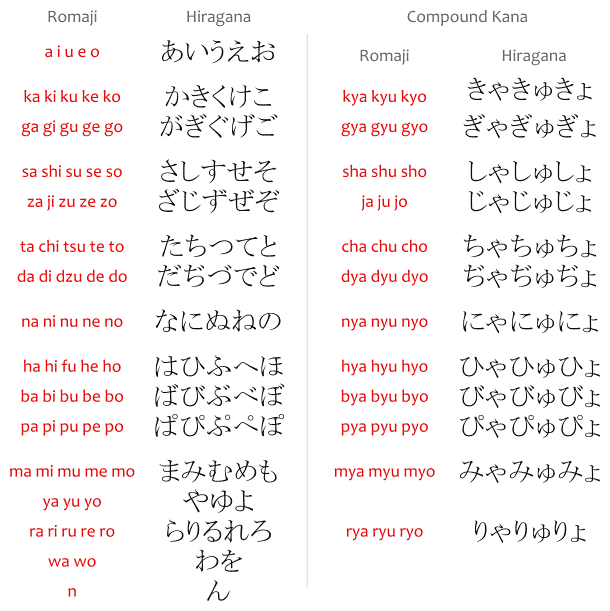The hiragana 平仮名 is one of the three Japanese "alphabets". It's counterpart of the katakana カタカナ. Both hiragana and katakana are sometimes referred to as kana かな.
Unlike the kanji 漢字, whose readings may vary depending on the word, the way a kana such as hiragana is read always stay the same.
The hiragana is normally used to write the Japanese particles, the furigana 振り仮名, the okurigana 送り仮名, onomatopoeic and mimetic words, and to write other simple, common words and auxiliaries that aren't written with kanji. Aesthetically, it's chummier than the other "alphabets."
Chart
For reference, the romaji chart including only the hiragana:
| a あ |
i い |
u う |
e え |
o お |
| ka か |
ki き |
ku く |
ke け |
ko こ |
| ga が |
gi ぎ |
gu ぐ |
ge げ |
go ご |
| sa さ |
shi し |
su す |
se せ |
so そ |
| za ざ |
ji じ |
zu ず |
ze ぜ |
zo ぞ |
| ta た |
chi ち |
tsu つ |
te て |
to と |
| da だ |
di ぢ |
dzu づ |
de で |
do ど |
| na な |
ni に |
nu ぬ |
ne ね |
no の |
| ha は |
hi ひ |
fu ふ |
he へ |
ho ほ |
| ba ば |
bi び |
bu ぶ |
be べ |
bo ぼ |
| pa ぱ |
pi ぴ |
pu ぷ |
pe ぺ |
po ぽ |
| ma ま |
mi み |
mu む |
me め |
mo も |
| ya や |
yu ゆ |
yo よ |
||
| ra ら |
ri り |
ru る |
re れ |
ro ろ |
| wa わ |
n ん |
wo を |
A few notes:
- The layout above is called gojūon 五十音, "fifty sounds," although it's only really fifty without diacritics.
- Different romaji systems have different romaji for the same kana, e.g. ふ is fu in some systems, hu in others.
- zi-di-zu-dzu じぢずづ, known as yotsugana 四つ仮名, are pronounced identically in some regions of Japan.
- wo を is always the wo を particle, and pronounced the same as o お.
- When ha は represents the wa は particle, it's pronounced wa わ.
- When he へ represents the e へ particle, it's pronounced e え.
- The small a-i-u-e-o ぁぃぅぇぉ may be used to mark long vowels.
- The small tsu っ may be used to mark geminate consonants.
- あ゙, an a with dakuten 濁点, and similar characters exist only in writing, having no actual pronunciation. They're used, for example, when a character is screaming "ahhhhhhh" in manga.
- A long ku く in vertical writing is an unusual iteration mark.
- A shi し written on a corner of a speech balloon in manga is a small sweat drop.
Next you have the diphthongs (compound kana) spelled using the small kana ゃゅょ.
| kya きゃ |
kyu きゅ |
kyo きょ |
| gya ぎゃ |
gyu ぎゅ |
gyo ぎょ |
| sha しゃ |
shu しゅ |
sho しょ |
| ja じゃ |
ju じゅ |
jo じょ |
| cha ちゃ |
chu ちゅ |
cho ちょ |
| dya ぢゃ |
dyu ぢゅ |
dyo ぢょ |
| nya にゃ |
nyu にゅ |
nyo にょ |
| hya ひゃ |
hyu ひゅ |
hyo ひょ |
| bya びゃ |
byu びゅ |
byo びょ |
| pya ぴゃ |
pyu ぴゅ |
pyo ぴょ |
| mya みゃ |
myu みゅ |
myo みょ |
| rya りゃ |
ryu りゅ |
ryo りょ |
For reference, as an image:
Source: japanesewithanime.com (CC BY-SA 4.0)

No comments: